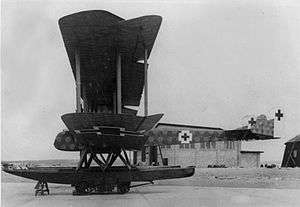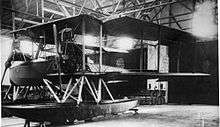Gotha WD.14
| WD.14, WD.20, and WD.22 | |
|---|---|
 | |
| Role | Torpedo bomber |
| National origin | Germany |
| Manufacturer | Gotha |
| First flight | 1916 |
| Primary user | Imperial German Navy |
| Number built | 69 |
|
| |


The Gotha WD.14, WD.20, and WD.22 (for Wasser Doppeldecker - "Water Biplane") were a family of biplane torpedo bomber floatplanes developed in Germany during World War I.
Development
They were conventional biplanes, essentially enlarged versions of the WD.11 and like it they had twin engines mounted tractor-fashion on the lower wing. The wider fuselage of these aircraft allowed the pilot and observer to sit side-by-side in the open cockpit, and a second 7.92 mm (.312 in) machine gun was added in an open dorsal position. Hinges were added to the wings, allowing them to be folded for storage.
69 WD.14s were built, but were found to be ineffective in their intended role of torpedo bomber, since their low speed made them extremely vulnerable to defensive fire. Many were subsequently converted into mine layers, and some were even used as transports, landing machine gun detachments during Operation Albion in October 1917. The WD.20 differed from the WD.14 only in having large auxiliary fuel tanks for long-range reconnaissance and having no torpedo- or mine-carrying capability.
A small number of generally similar WD.22 prototypes were built, these differing from the WD.20 in having two extra engines added, creating two tractor-pusher pairs, one on each wing.
Specifications (WD.14)
General characteristics
- Crew: Three, pilot, observer, gunner
- Length: 14.45 m (47 ft 5 in)
- Wingspan: 25.50 m (83 ft 8 in)
- Height: 5.00 m (16 ft 5 in)
- Wing area: 132.0 m2 (1,421 ft2)
- Empty weight: 3,150 kg (9,845 lb)
- Gross weight: 4,642 kg (10,234 lb)
- Powerplant: 2 × Benz Bz.IV, 150 kW (200 hp) each
Performance
- Maximum speed: 130 km/h (80 mph)
- Endurance: 8 hours
- Rate of climb: 1.3 m/s (250 ft/min)
Armament
- 1 × trainable, forward-firing 7.92 mm (.312 in) Parabellum MG14 machine gun in nose for observer
- 1 × trainable, rearward-firing 7.92 mm (.312 in) Parabellum MG14 machine gun in dorsal position
- 1 × 725 kg (1,600 lb) torpedo
References
| Wikimedia Commons has media related to |
- Taylor, Michael J. H. (1989). Jane's Encyclopedia of Aviation. London: Studio Editions. p. 428.
- World Aircraft Information Files. London: Bright Star Publishing. pp. File 895 Sheet 09.
- S, W (March–April 2010). "Rara Avis - Gotha WD.14 - A WW1 'Swordfish'!". Windsock Worldwide. Albatros Productions. 26 (2): 15–18.